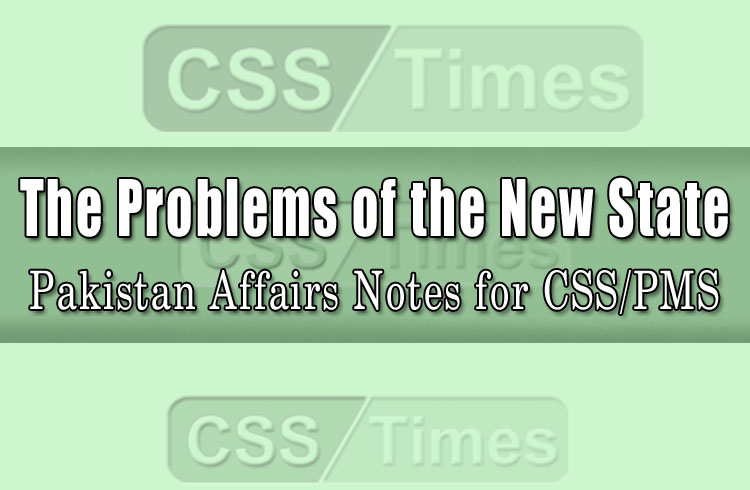The Problems of the New State
Pakistan Affairs Notes for CSS/PMS
The attainment of independence brought an end to one phase of the struggle and marked the beginning of a new one for setting up and running a viable, stable and prosperous state. Pakistan began its independent life under very difficult and unfavorable circumstances. Pakistan faced serious problems in the initial stages.
- New Administration
- Division of Assets
- Integration of Princely States
- Communal Riots and Arrival of Refugees
- Canal water and trade issues
1: New Administration
The shortage of trained human power especially senior officers was a serious problem in the setting up of federal government in Karachi. Most of them had migrated to India. There was a shortage of office space, equipment and furniture. This disturbed the direct connections between the federal government and provincial governments. On the other hand, the provincial governments were overburdened that needed very accurate connection between the centre and the provinces to solve the problems of the Muslim refugees who had nothing to eat, drink, wear, rest, etc. To counter the critical situation, the official system should have been efficient but due to the lack of all these facilities the administrative authorities were painfully facing difficulties.
Check also: Pakistan Affairs Notes for CSS/PMS
2: Division of Assets
The Indian government was not cooperative for transfer of record and equipment to Pakistan.
The civil administration was not handing over the promised financial, military, and other shares that created mountainous hurdles to eradicate the pains and miseries of the refugees.
Financial Assets
The full financial share of Pakistan was not transferred. Initially rupees 200 million were transferred that were not sufficient to meet the expenditures of the newly born state. The Indian government was so reactionary that it tried its level best to block these funds to suffocate the newly born Muslim state as they expected foolishly that Pakistan would collapse and rejoin India soon after its existence. They did not release the remaining funds until Gandhi’s threat of marn bert (fast until death). Under this pressure, more funds were sent in early 1948 but no installment was later paid.
Check also: Everyday Science MCQs
Military’s Division
As far as the problem in dividing man power there was no serious setback because the division was not in the hand of third person and Muslims were free to come to their dreamland, Pakistan. Anyhow, their shifting was slow and insecure. There were obstacles in the Pakistan’s share of weapons, equipment, and stores. The broken and damaged stuff was sent by India. Pakistan did not get any ordinance factory. Reorganization of the Armed Forces was another tough job and the there was no army officer up to the rank of colonel. The shortage of experienced officers convinced British officers to continue their services. This also accelerated undue promotion in the military services to fill the gap.
3: Integration of Princely States
There were over 560 princely states in India on the verge of the partition of India. About 500 states had joined India before August 15 because of the motivation by V. P. Menon and Mountbatten. The princes were inclined to honour every gesture of the British representative sothey conceded what the member of the Royal family (Mountbatten) wished. The Hindu-British conspiracy blocked states to join Pakistan.
Junagadh
It was a small state with access to sea having about 7 lakh population and 3377 mile area. The ruler was Muslim while the majority of its population was Hindu. The ruler decided to accede to Pakistan and Pakistan also accepted the accession. In November 1947, the Indian troops entered the state and took its control. The referendum favoured India.
Hyderabad
It was geographically big and financially a rich state. Its ruler was Muslim and majority population was Hindu. It was surrounded by India from all sides. The Nizam wanted to stay independent. Mountbatten discouraged him and signed Standstill Agreement. But India built pressure on the Nizam by sending its troops in September 1948 claiming that serious law and order situation had developed. The state was integrated in India.
Kashmir
The most important state was Kashmir naturally connected with Pakistan. Its ruler was Hindu while population was Muslim. The population inclined towards Pakistan but the Hindu ruler declared to join India. The Kashmiri people revolt against the ruler in Poonch area and soon it became widespread. The ruler sought Indian support. India demanded accession. On October 27, 1947 Indian troops landed in Srinagar. The people continued their struggle for independence and India promised to finally settle the matter with reference to the people under the UN Resolutions.
4: Communal Riots and Refugees
The Communal riots occurred earlier in August 1946. The killing of Muslims in Indian areas forced them to leave India. The Sikhs and Hindus attacked the refugee caravans and trains. There were organized gangs to kill the Muslims. The refugee problem created critical condition in the border areas. The massive migration proved serious economic and humanitarian problems for the new state. The military was asked to help cope with the refugee problem.
Check also: Unveiling Pakistan’s Nuclear Capabilities
5: Canal Water Problem
The major rivers flow from Kashmir and some canal heads located in India. In 1948, India cut off water to some canal that was a serious threat to agriculture in West Pakistan. The Indian plans to build water storage on the rivers that are vital for Pakistan’s economy worsened the situation. It also showed the traditional anti-Muslim attitude. The World Bank settled the problem in September 1960 (Indus Water Treaty).
6: Trade Problem and the Economy
India devalued its currency in 1949 but Pakistan refused to do so. It stopped trade that adversely affected Pakistan’s economy as it depended on trade from India. Pakistan had inherited a weak economy and poor industrial base. The beginning years of Pakistan were troubled and difficult due to the India’s non-helpful policy and the war in Kashmir. It had profound impact on Pakistan’s worldview and its relations with India. Pakistan strived for its survival and security. Many Indians and the British predicted the collapse of Pakistan. They were of the opinion that very soon the Muslims would realize their blunder. They would be forced by the circumstances to go back to join India. But PAKISTAN, by the grace of Almighty Allah, was able to meet the challenge even with its problems.
Courtesy: CSSForum
Check Other NOTES for Pakistan Affairs
- Unveiling Pakistan’s Nuclear Capabilities
- Allama Iqbal’s Contribution to Islamic Thought and Literature
- The Asian Development Bank’s Investment in Pakistan: A Review
- The Future of Pakistan’s Defence System: Prospects and Challenges
- The Politics of IMF Loans to Pakistan: Debates and Controversies
- A Vision for a Stronger Pakistan: The Roadmap to Independent Foreign Policy
- Reinventing a Nation: Reimagining Pakistan
- Understanding the Role of Caretaker Government in Pakistan’s Democratic Process
- The National Action Plan: An Overview
- Allama Iqbal | The Name — Not The Philosophy — Lives On







